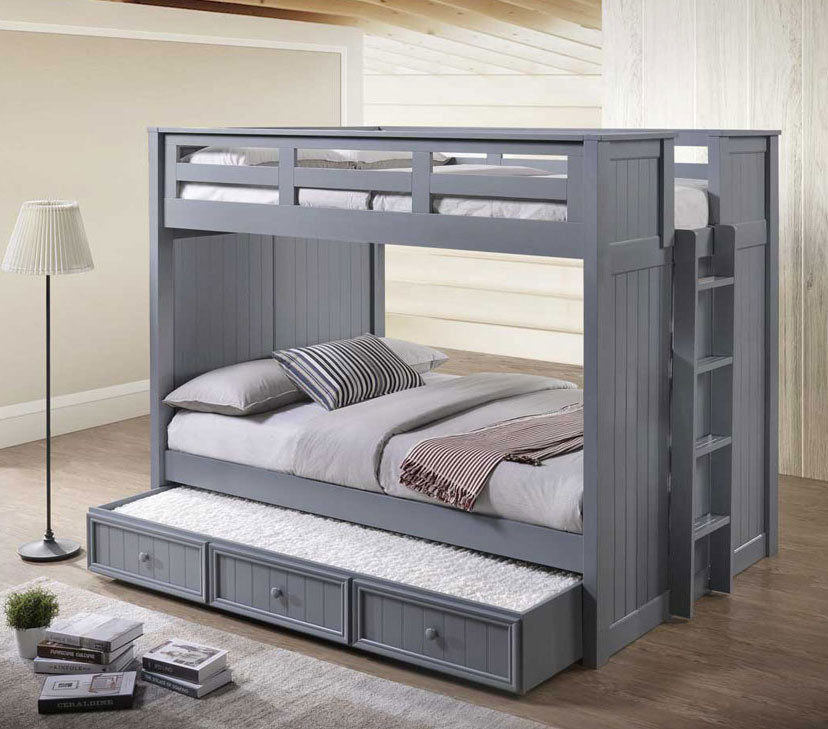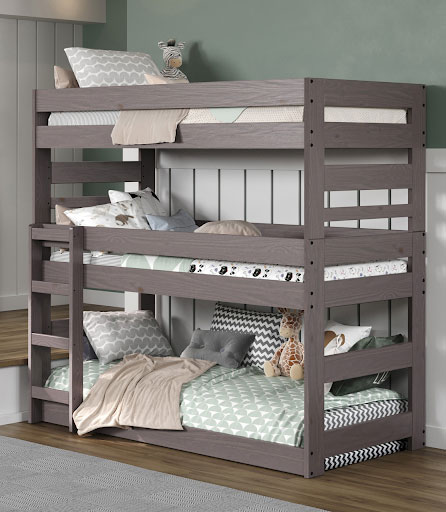Categories
Categories
Bunk Bed Safety Rails: Importance and Installation Tips
Posted by on
A popular choice in both children's bedrooms and adult spaces alike, bunk beds offer a unique combination of practicality and style. While space-saving, their design brings forth significant safety considerations, especially when it comes to preventing falls. Here, we delve into the critical importance of safety rails on bunk beds, covering their necessity, selection, installation, customization, and maintenance.
Why Safety Rails are a Must for Bunk Beds
Safety rails are essential for ensuring your safety. They are not merely an accessory but vital to preventing accidental falls and injuries.
Preventing Falls and Ensuring Safety
The primary function of safety rails is to provide a physical barrier, preventing sleepers from rolling off the bed. This is particularly crucial in children's bunk beds, as kids are prone to move around more during sleep and may not have the same awareness of height dangers as adults.
Legal and Safety Standards for Bunk Bed Rails
The safety standards and legal requirements for bunk bed rails are clearly outlined by the U.S. Consumer Product Safety Commission (CPSC), designed to minimize the risks associated with bunk bed usage.
According to the CPSC:
1. Upper Bunk Guardrails Requirement: Bunk beds must have at least two guardrails on the upper bunk. This provision ensures a protective barrier on each side of the bed, significantly reducing the risk of falls from the upper bunk.
2. Guardrail Dimensions and Placement: The regulations stipulate that one of the guardrails on the upper bunk must run continuously from one end of the bed to the other, especially on the side opposite the ladder. This continuous guardrail provides uninterrupted safety for the entire length of the bed.
3. Lower Bunk Guardrails Exemption: Guardrails are not mandated for lower bunks if the mattress foundation is 30 inches or less from the floor. This exemption considers the reduced risk of injury from falls due to the lower height of these bunks.
4. Gap Specifications: The CPSC also specifies the maximum allowable gap between the slats of the guardrails. This is to prevent accidental slips or entrapment, further enhancing the bunk bed's safety.
These CPSC regulations are legal requirements and serve as a vital guideline for manufacturers and consumers. They provide clear standards for designing and constructing bunk beds, aiming to ensure the highest level of safety for users. Compliance with these standards is essential for any bunk bed design, especially in children's bedrooms, hostels, or dormitories, where safety is paramount.
Selecting the Right Safety Rails for Your Bunk Beds
When it comes to bunk bed safety, selecting the right safety rails is paramount. It's not just a matter of choosing a rail that fits; it's about ensuring maximum safety, comfort, and suitability to your specific bunk bed type. The decision involves a thoughtful consideration of materials, compatibility with different bunk bed styles, and the user's unique needs, be it a child or an adult.
Compatibility with Different Bunk Bed Types
Ensuring compatibility between the safety rails and the bunk bed type is essential for effective safety.
Twin Bunk Beds
For twin-over-twin bunk beds, choosing rails specifically designed to fit the bed's dimensions and style is essential. This ensures a secure and snug fit, which is vital for preventing accidents. Additionally, the height of the rails should be considered, especially when using thicker mattresses, to provide adequate protection against falls.
Loft Beds
For loft beds, the safety concerns are slightly different due to their elevated design. The safety rails must be securely attached to the bed frame, providing stable and reliable safety. Opting for rails that cover the entire bed length is advisable, as it maximizes safety by reducing the risk of falls from any part of the bed.
Triple Bunk Beds
Known for their unique structure and increased height, triple bunk beds require safety rails that offer enhanced stability and strength. Given the multiple sleeping areas and the bed's height, choosing custom-sized rails tailored to fit the specific dimensions of the triple bunk beds is essential for ensuring optimal safety.
The correct compatibility of safety rails with the bunk bed type maximizes safety and maintains the bed's functional integrity and aesthetic appeal, creating a comfortable and secure sleeping environment.
Comprehensive Guide to Installing Bunk Bed Safety Rails
Ensuring that safety rails on bunk beds are properly installed is a critical step in safeguarding the well-being of anyone using them. A meticulous installation process guarantees the functional effectiveness of the safety rails and fortifies the bunk bed's overall safety.
Tools and Preparation for Installation
Before installing your safety rails, organizing all necessary tools and materials is crucial. A standard set of tools typically includes:
- A reliable screwdriver, preferably with interchangeable heads to accommodate different screw types.
- A power drill can be crucial for creating pilot holes if they aren't pre-drilled.
- A wrench or a set of wrenches for tightening bolts, especially for metal rails.
- Measuring tape to ensure precise placement and alignment of the rails.
In addition to assembling tools, it's crucial to read through the installation instructions thoroughly. This step ensures that you understand the process and have all the required parts ready. Inspecting the bed frame to locate the correct attachment points for the rails is also a critical part of the preparation process. This preparatory phase lays the groundwork for a smooth and successful installation.
Step-by-Step Installation Process
The installation of bunk bed safety rails typically follows a structured process:
Aligning the Rails
Start by aligning the safety rails with the pre-drilled holes on the bunk bed frame. This step ensures the rails are securely attached to the bed.
Securing the Rails
Use screws or bolts to fasten the rails to the frame. Ensuring these fixtures are tightened adequately eliminates wobble or movement in the rails.
Final Inspection
Once installed, check the rails thoroughly by applying pressure to mimic a sleeper's movements. The aim is to ensure the rails remain firmly in place and can support the necessary weight without yielding.
Regular Check-ups
After installation, periodic checks are recommended to maintain the integrity of the safety rails. This includes tightening any loose screws or bolts and ensuring that the rails continue to provide the necessary protection.
By following these steps, you can be confident that the safety rails on your bunk bed are installed correctly and securely. This enhances the bunk bed's safety and provides peace of mind, knowing that the bed's occupants are protected from potential falls or accidents. The correct installation of safety rails is a straightforward yet vital aspect of bunk bed safety, essential for creating a secure and worry-free sleeping environment.
Maintenance and Safety Checks for Bunk Bed Rails
Regular maintenance and thorough safety checks are indispensable to ensure that bunk bed safety rails continue to offer optimal protection. These routines are not just about preserving the rails' physical condition but are also pivotal in safeguarding the well-being of those who use the bunk bed. Consistent attention to the condition of the safety rails can prevent minor issues from escalating into major safety hazards.
Regular Inspection and Maintenance
The key to maintaining the integrity of safety rails lies in regular inspection and prompt maintenance. This process involves:
- Routine Checks: Periodically examine the safety rails for any visible signs of damage, wear, or tear. This includes looking for cracks in wooden rails, rust or bending in metal rails, and checking for any other structural weaknesses.
- Tightening Fittings: Over time, screws and bolts that secure the rails to the bunk bed may become loose. Regularly tightening these fittings is crucial to prevent the rails from becoming wobbly or detached.
- Assessing Stability: Regularly assess the overall stability of the rails. Apply gentle pressure to the rails to mimic a sleeper's movements and ensure they remain firmly in place.
- Replacement Parts: Be prepared to replace parts that show significant wear or damage. Keeping an eye on the condition of the rails can help you determine when it's time to replace them entirely to maintain safety.
Incorporating these maintenance steps into your routine ensures that the safety rails retain their structural integrity and continue to serve their primary function of preventing falls.
Recognizing and Addressing Wear and Tear
As with all furniture, wear and tear on safety rails are inevitable over time — recognizing these signs early is essential for maintaining the safety and integrity of the bunk bed. Key indicators to watch for include:
- Cracks in Wooden Rails: Look for any splits or cracks in the wood, which can compromise the rail's strength.
- Bending in Metal Rails: Noticeable bending or warping in metal rails can indicate a weakness that needs to be addressed.
- Rust or Corrosion: For metal rails, rust or corrosion can weaken the metal and compromise its ability to bear weight safely.
- Loose or Missing Components: Regularly check for any loose, missing, or damaged components like screws, bolts, or brackets.
Upon identifying these signs, it's imperative to take prompt action. Minor issues like loose fittings can often be easily fixed, while more significant problems like cracks or severe bending may necessitate a total replacement of the safety rails. It's a proactive approach that keeps minor damages from turning into major safety concerns, ensuring the bunk bed remains a secure and reliable piece of furniture in your home.
Bunk bed safety hinges on correctly selecting, installing, and maintaining safety rails. Following the guidelines and tips outlined in this guide will help ensure a safe and secure environment, particularly in spaces like children's bedrooms and hostels. For further guidance or to explore our range of safe and stylish bunk beds, contact Just Bunk Beds today!
 Loading... Please wait...
Loading... Please wait... 
 Buy Now & Pay Later!
Buy Now & Pay Later! 


